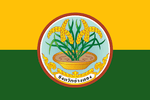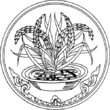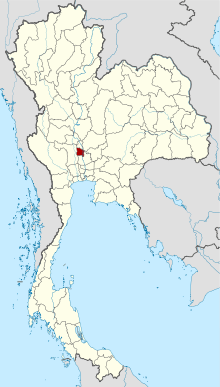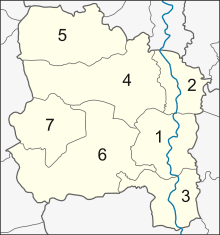Ang Thong Province
Ang Thong (Thai: อ่างทอง, pronounced [ʔàːŋ tʰɔ̄ːŋ]) is one of the central provinces (changwat) of Thailand. The name "Ang Thong" means 'gold basin', thought to have derived from the basin-like geography of the area, and the golden color of the rice grown in the region.
Ang Thong อ่างทอง | |
|---|---|
Kham Yat Palace Hall, an ancient royal palace hall since Ayutthaya period. Currently, it is located in Pho Thong District. | |
 Flag  Seal | |
| Motto(s): "พระสมเด็จเกษไชโย หลวงพ่อโตองค์ใหญ่ วีรไทยใจกล้า ตุ๊กตาชาววัง โด่งดังจักสาน ถิ่นฐานทำกลอง เมืองสองพระนอน" ("Phra Somdej Ket Chaiyo, Reverend Father To large body, Brave Thai, Palace dolls, Famous wicker, Drum Settlement and Two sleeping Buddha cities") | |
 Map of Thailand highlighting Ang Thong Province | |
| Country | Thailand |
| Capital | Ang Thong town |
| Government | |
| • Governor | Wirawut Puttraserani (since October 2015) |
| Area | |
| • Total | 968 km2 (374 sq mi) |
| Area rank | Ranked 72nd |
| Population (2018)[2] | |
| • Total | 280,840 |
| • Rank | Ranked 71st |
| • Density | 290.1/km2 (751/sq mi) |
| • Density rank | Ranked 12th |
| Human Achievement Index | |
| • HAI (2017) | 0.5298 "low" Ranked 69th |
| Time zone | UTC+7 (ICT) |
| Postal code | 14xxx |
| Calling code | 035 |
| ISO 3166 code | TH-15 |
Neighboring provinces are (from north clockwise) Sing Buri, Lopburi, Ayutthaya, and Suphanburi.
Ang Thong native handicrafts include moulded court dolls, firebrick, and wickerwork.
Ang Thong has more than 200 Buddhist temples, but there are nine distinctive temples that are promoted as "Paying Homage to Nine Auspicious Temples" consists of Wat Chaiyo Worawihan, Wat Khun Inthapramun, Wat Pa Mok Worawihan, Wat Tonson, Wat Mahanam, Wat Thasutthawat, Wat Siroi, Wat Khian and, Wat Muang where the Great Buddha of Thailand is enshrined.[4]
Geography
Ang Thong occupies a low river plain, created by the Chao Phraya and the Noi Rivers. It has neither mountains nor forests, but consists of mostly agricultural land. The two rivers, together with many canals (khlongs), provide enough water for rice farming.[5]
History
Ang Thong was historically known as Wiset Chai Chan, on the Noi River. It was an important border town of the Ayutthaya Kingdom during the wars with Burma, as the Noi River served as a natural obstacle for advancing troops.
During the reign of King Taksin after the fall of Ayutthaya, the main city of the province was moved to the Chao Phraya River, and named Ang Thong, as the Noi River had become silted and too shallow for transportation.
Ang Thong is the provenance of Li Ke, the native folk song, and the hometown of Nai Dok and Nai Thongkaeo, two heroes of the Bang Rachan Battle.
Khun Rong Palat Chu is another local hero of Ang Thong. His heroism is little known when compared to the villagers of Bang Rachan because only two lines were recorded in the Thai chronicles. He grouped up and led four hundred volunteer sword fighters under the name "Kong Attamat" to accompany the royal army from the capital during the royal army's settlement at Kui Buri of Prachuap Khiri Khan. His group received a command to obstruct the Burmese army 8,000 people at Ao Wa Khao (now is in Ao Noi, Mueang Prachuap Khiri Khan) in 1759 when King Alaungpaya of Burma invaded Myeik (Burmese–Siamese War (1759–60)) which was a part of Ayutthaya Kingdom at that time. In the end, they all died of four hundred people. Nowadays, there is a monument built to commemorate his heroism at Wat Si Roi, Wiset Chai Chan.[6]
Symbols
The provincial seal shows some golden ears of rice in a bowl of water. This symbolizes the fertility of province as one of the major producers of rice. The provincial tree is the gaub tree (Diospyros malabarica). The provincial fish is red tailed tinfoil (Barbonymus altus).[4]
Administrative divisions

Provincial government
The province is divided into seven districts (amphoes). The districts are further subdivided into 73 subdistricts (tambons) and 513 villages (mubans).
Local government
As of 26 November 2019 there are[7]: one Ang Thong Provincial Administration Organisation (ongkan borihan suan changwat) and 21 municipal (thesaban) areas in the province. Ang Thong has town (thesaban mueang) status.[8] Further 20 subdistrict municipalities (thesaban tambon). The non-municipal areas are administered by 43 Subdistrict Administrative Organisations - SAO (ongkan borihan suan tambon).[2]
Human achievement index 2017
| Health | Education | Employment | Income |
| 76 | 23 | 68 | 55 |
| Housing | Family | Transport | Participation |
 |
 |
 |
|
| 27 | 75 | 35 | 28 |
| Province Ang Thong, with an HAI 2017 value of 0.5298 is "low", occupies place 69 in the ranking. | |||
Since 2003, United Nations Development Programme (UNDP) in Thailand has tracked progress on human development at sub-national level using the Human achievement index (HAI), a composite index covering all the eight key areas of human development. National Economic and Social Development Board (NESDB) has taken over this task since 2017.[3]
| Rank | Classification |
| 1 - 15 | "high" |
| 16 - 30 | "somewhat high" |
| 31 - 45 | "average" |
| 45 - 60 | "somewhat low" |
| 61 - 77 | "low" |
| Map with provinces and HAI 2017 rankings |
 |
Notable people
- Somsak Prissanananthakul: politician
- Pleumjit Thinkaow: world-class volleyball player
- Pipob Thongchai: activist
- Kohtee Aramboy: comedian
Notes
Reports (data) from Thai government are "not copyrightable" (Public Domain), Copyright Act 2537 (1994), section 7.
References
- Advancing Human Development through the ASEAN Community, Thailand Human Development Report 2014, table 0:Basic Data (PDF) (Report). United Nations Development Programme (UNDP) Thailand. pp. 134–135. ISBN 978-974-680-368-7. Retrieved 17 January 2016, Data has been supplied by Land Development Department, Ministry of Agriculture and Cooperatives, at Wayback Machine.
- "รายงานสถิติจำนวนประชากรและบ้านประจำปี พ.ศ.2561" [Statistics, population and house statistics for the year 2018]. Registration Office Department of the Interior, Ministry of the Interior (in Thai). 31 December 2018. Retrieved 20 June 2019.
- Human achievement index 2017 by National Economic and Social Development Board (NESDB), pages 1-40, maps 1-9, retrieved 14 September 2019, ISBN 978-974-9769-33-1
- Super User (2015-05-29). "ปลาประจำจังหวัด" [Provincial fish]. Angthong Province (in Thai). Retrieved 2020-04-22.
- "Ang Thong". Tourism Authority of Thailand (TAT). Retrieved 14 October 2016.
- "บวงสรวง 'ขุนรองปลัดชู' วีรชนที่ถูกลืมจากประวัติศาสตร์ไทย" [Tribute to 'Khun Rong Palat Chu' unsung hero from Thai history]. Thaipost (in Thai). 2018-11-21. Retrieved 2020-04-26.
- "Number of local government organizations by province". dla.go.th. Department of Local Administration (DLA). 26 November 2019. Retrieved 10 December 2019.
71 Ang Thong: 1 PAO, 1 Town mun., 20 Subdistrict mun., 43 SAO.
- "พระราชกฤษฎีกา จัดตั้งเทศบาลเมืองอ่างทอง จังหวัดอ่างทอง พุทธศักราช ๒๔๗๙" [Royal Decree Establishing of Thesaban Mueang Ang Thong, Changwat Ang Thong, Buddhist Era 2479 (1936)] (PDF). Royal Thai Government Gazette. 54: 842–845. 28 November 1936. Retrieved 10 December 2019.
External links

- Ang Thong provincial map, coat of arms and postal stamp
- Flag of Ang Thong Province